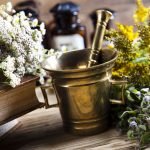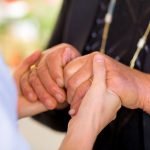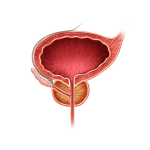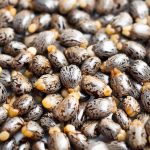Notes from the Field: August, 2019
Nature Cure Clinical Pearls
Jared L. Zeff, ND, VMNI, LAc
The following is a not an article prepared for a medical journal. Rather, this is a commentary on the medicine, a running set of observations about practice in the field. It’s not meant to be a peer-reviewed presentation; rather, these are notes and thoughts from a practicing naturopathic physician, a primary care doc in general practice.
A Case of Childhood Asthma
“Jason” was brought to me by his mother. He is 10 years old and suffering from asthma and allergies. He has hay fever in the spring. He takes 2 puffs of fluticasone twice daily, and uses an albuterol inhaler as needed – usually every day, at least once. He is anaphylactic to tree nuts and eggs, and very allergic to animal dander: no pets allowed. He had no asthma until about 1 ½ years ago, when he got a cold that went into his chest and he suddenly began wheezing. He has never stopped wheezing since. Jason presented to my office quite anxious, very concerned about what I might do in the way of examining him. His O2 saturation in the office was 95%, with a heart rate of 70 beats per minute. I had him blow into a peak flow meter, and he blew 140, which should have been about 320 or so given his age and size. Auscultation of the lungs revealed full breath sounds, with some slight rhonchi and rales. All of this was after using the fluticasone that morning.
Given his symptom picture, I gave him a dose of Arsenicum album 30C. Within 5 minutes he reported that it was easier to breathe, and his O2 sat read 97%. That seemed like a good remedy for him. I began a dietary evaluation, using the old technique of O.G. Carroll, ND, ie, looking for a food that might be driving a digestive disturbance and generating the toxemia that likely underlies the inflammation in the lungs that is generating the asthma. I made him a botanical mix of Amni, Glycyrrhiza, Inula, Tussilago, and Lobelia, and advised him to take 20 drops 3 times daily to help improve the breathing. I gave him a bitter tonic to enhance digestion, and I instructed his mom on how to give him constitutional hydrotherapy treatments at home – once daily, 5 days each week, until his breathing improved.
I saw Jason a few days ago, about 1 month after his first visit. His mom reported that his breathing has dramatically improved, that he has not had any wheezing since leaving my office. He has not needed any fluticasone, which he had been using several times each week per my instructions. If he resumes the medication, we will cut the dosage in half for a couple of weeks; if he continues doing well, we will cut it once more, then be off of it. He had been following my dietary advice scrupulously. His mom also reported that his allergies have lightened, that he is just not as reactive as before. And so it goes with childhood asthma, usually. Asthma is an epidemic disease among children, with currently about 8% of US children affected.1 But it is quite easy to treat. And I do not mean medicate; I mean cure. If this child follows the usual pattern, he will be asthma-free in a few months with no medication, and his anaphylactic tendency will be reduced substantially.
My Approach to Asthma
The simple “algorithm” I follow is this:
- Get the diet right, to improve digestion and reduce toxemia. It is toxemia that is usually driving the inflammation in the lung. Smoke, dander, dust, etc, may “trigger” the already irritated lungs, but these triggers are not the cause. Remove the offending food, improve digestion, reduce toxemia, and the triggers will have minor effects, if any.
- Find a homeopathic medicine to use for acute exacerbations. I test this in the office, as demonstrated in the case above, to make sure the remedy is correct. Use the remedy before using an inhaler, but use the inhaler if needed.
- I usually provide a lung tonic to improve circulation, reduce inflammation, etc. This helps with the initial stages of healing.
- Constitutional hydrotherapy drives the improvement and speeds the process. Usually it is helpful; in some cases it is essential.
- Manipulate the upper spine/lower neck, where the nerves exit the spine to innervate the lungs. This is not always needed, but can be quite helpful.
In a recent article on individualized prescription of homeopathic medicine in the treatment of asthma, which is cited on PubMed,2 the authors concluded,
Due to both qualitative and quantitative inadequacies, proofs supporting individualized homeopathy remained inconclusive. The trials were positive (evidence level A), but inconsistent, and suffered from methodological heterogeneity, “high” to “uncertain” risk of bias, incomplete study reporting, inadequacy of independent replications, and small sample sizes.
This article has been used to demonstrate that homeopathic medicine is not effective in the treatment of asthma.
The problem with this approach is that it singularly employs homeopathy. I find that homeopathic medicine is essential but that the key to cure is the diet and the reduction of toxemia. A well-selected remedy will help substantially; however, it is not sufficient, in my experience, to cure the case. But this is naturopathic medicine: the integrated combination of healing modalities that are appropriate to the case and applied within the framework of the therapeutic order.
Aude Sapere
The term, aude sapere, (originally from the Roman poet Horace in 20 BCE) is listed by Andre Saine, ND, of Ontario, as the 7th principle of medicine. It comes from Hahnemann and translates as “dare to know,” or more loosely as “dare to think for yourself”; it is also the subtitle of the Organon in its second edition.
Recently, there has been much discussion in our profession regarding the efficacy of homeopathy. A recent article by David Nelson set the naturopathic internet chattering: “The Bell Tolls for Homeopathy: Time for Change in the Training and Practice of North American Naturopathic Physicians”.3 (Dr Paul Theriault wrote a great response to this article, published in NDNR.4) I guess we could say that the basic tenet of Nelson’s article is that homeopathy, at best, is placebo, and is unsupported by any reputable science.
I first encountered homeopathy when I began school at NCNM in 1975. I considered myself a scientist, having just graduated from the University of California with a bachelor’s degree in science, and was a lifelong student of biology and natural science. “I am not a fool,” I said to myself. “Do not expect me to believe that one can take something diluted beyond Avogadro’s number and have it produce a physical response.” I came to the rapid conclusion that homeopathy was a self-deluded placebo cult. I witnessed some of my colleagues pouring over these arcane books filled with symptoms associated with remedies. “How foolish, like an arcane religion,” I thought. Then one day, in my little house in Wichita, I heard a yelp as I was studying. I ran outside and witnessed a dog lying in the street, having just been hit by a car, which was speeding away. They dog was quite injured and going into shock. I had just purchased a required homeopathic first-aid kit. I ran inside, grabbed the kit, and gave the dog a dose of Aconitum 30C. Almost instantly, the dog returned to consciousness. I took him to the vet, who doctored him into recovery. But, I wondered, how can a placebo work on a dog in shock?
Later, still not convinced fully, I took a dose of Sulphur 200C. I had been plagued by a number of warts on my hands and feet for years. I had several large warts on my right thumb. I used to walk around with my hand in my pocket because I was embarrassed by their ugliness. I had heard in class that day about the provings of Sulphur, and thought I would give it a try. Within 2 weeks all the warts were gone, except for 1 small wart on my foot. I was shocked and pleased. It really worked!
Then later, after I had been in practice a couple of years, I had another remarkable encounter. I had ordered a 10M potency of Arnica – my first exploration into a really high potency. I do not recall why I ordered it, but I had just gotten it that day in the mail, and had it in my pocket when I returned home after work. It was summer, and I was putting a fence in my yard, pounding steel fence-posts into the earth on which to string wire. I accidently smashed my thumb with a sledge hammer against the steel post. I thought I must have smashed the bone. I remembered the Arnica 10M in my pocket, and immediately took a dose. I was amazed to watch my thumb over the next few minutes. I had taken the remedy within a few seconds of the injury. My flattened thumb filled out and never hurt. No bruise developed. The thumb was mildly sore to the touch but did not turn black, and the nail did not fall out as I had expected it would. I learned something about homeopathic medicine that day: that if the remedy is given early enough, the progression of pathology that normally and inevitably proceeds can be halted. How this happens, of course, I do not know, but I experienced it. The nail did not turn black as it should have. The remedy stopped the pathologic cascade.
Clinical Homeopathy
One day I was visiting a colleague who was also a friend. We were talking about a particular case and I suggested a homeopathic remedy, to which my friend kind of chuckled. He said he did not use homeopathic medicine. We continued talking about the case, and went on to discuss other things, but when I returned home I continued thinking about my friend who did not use homeopathy. I assumed that he had not had good instruction in the medicine, and I hit upon a solution. I put together for him a few remedies with written instructions for their use in specific clinical situations in which I knew that they would have a beneficial effect. I sent him this little kit with a note explaining my good intention. When next I saw him, I asked whether he had used the kit and what he might have seen as a result. He laughed and explained to me that it was not that he did not know how to use homeopathy, but rather that he did not believe in homeopathy.
I tried to explain that homeopathy is not something one believes in; ie, it is not a religion (as I had once thought). It was a medical system with 200 years of clinical experience, practiced worldwide. He just would not have it. He was a materialist, he explained – a scientist – and could not believe in something so immaterial as homeopathy. I respected him as a physician, and valued him as a friend, and so I did not press the subject. He was not interested. But I have proven to myself the efficacy of this old system of medicine. I use it daily in practice, and have for over 40 years now. It works in babies and dogs. I may give a remedy that has no effect, but then give one that has a profound effect. All this demonstrates to the observer that the mechanism is certainly not placebo.
This brings me back to the beginning of this article. The week before young Jason was in my office, I had a visit from another anxious young boy with asthma. Like Jason, he was on a couple of inhalers, and also montelukast, a leukotriene inhibitor. But his breathing was impeded, auscultation demonstrated rales, his O2 sat was about 94, and his peak flow was about half what it should have been. As I was taking his case, his mom commented on his love of salt. He would even eat salt out of a bowl with a spoon. Well, just on a whim, I gave him a dose of Natrum muriaticum 30C. Within 1 minute, he seemed more relaxed. I rechecked his O2 sat, and it was now in the normal range. I had him blow into the peak flow meter, and his value had almost doubled. All this within about 5 minutes of taking the Natrum mur. His mom was amazed. I was pleased.
Homeopathy is not difficult. It takes lots of study and experience to become a great homeopath like Dr Saine, but even for the beginner one can expect much success. In our schools, homeopathy tends to be taught in a way that most students find unapproachable. It seems too difficult to repertorize each case, to spend an hour or 2 taking a case, then another 2 hours working through the repertorization. This is not how I practice. It is not how most of my friends practice. Kent told us that one needs only about 3 good symptoms to prescribe a good remedy: a good mental symptom, a good general symptom, and a peculiar symptom. Consider the above case. Anxiety (mental symptom), asthma (general symptom), and craving for salt (peculiar symptom). I gave him a rather obvious remedy, Natrum mur, and had success. I call this, “Clinical Homeopathy” – the rapid prescribing of remedies in clinical situations based upon the simple presentation.
Dare to try it.
Respectfully,
Jared L. Zeff, ND, VNMI, LAc
References:
- Asthma and Allergy Foundation of America. Asthma Facts and Figures. Updated June 2019. AAFA Web site. https://www.aafa.org/asthma-facts/. Accessed August 25, 2019.
- Qutubuddin M, Singh SM, Nayak C, et al. A Systematic Review of Controlled Trials of Homeopathy in Bronchial Asthma. Complement Med Res. 2019;26(2):111-117.
- Nelson DH, Perchaluk JM, Logan AC, Katzman MA. The Bell Tolls for Homeopathy: Time for Change in the Training and Practice of North American Naturopathic Physicians. J Evid Based Integr Med. 2019;24:2515690X18823696.
- Theriault P. Homeopathy: Correcting the Record. NDNR. 2019;15(3):12-16.
 Jared L. Zeff, ND, VNMI, LAc, is a licensed doctor of naturopathic medicine and a licensed acupuncturist. In addition to functioning as Medical Director at the Salmon Creek Naturopathic Clinic in Vancouver, WA, Dr Zeff teaches on the faculty at National University of Natural Medicine in Portland, OR, where he was also Dean from 1988 to 1993, and holds a professorship in Naturopathic Medicine. Dr Zeff is a graduate of the University of California, NCNM, and the Emperor’s College of Traditional Oriental Medicine. He, along with Pamela Snider, is the author of the AANP’s Definition of Naturopathic Medicine, and the Therapeutic Order concept.
Jared L. Zeff, ND, VNMI, LAc, is a licensed doctor of naturopathic medicine and a licensed acupuncturist. In addition to functioning as Medical Director at the Salmon Creek Naturopathic Clinic in Vancouver, WA, Dr Zeff teaches on the faculty at National University of Natural Medicine in Portland, OR, where he was also Dean from 1988 to 1993, and holds a professorship in Naturopathic Medicine. Dr Zeff is a graduate of the University of California, NCNM, and the Emperor’s College of Traditional Oriental Medicine. He, along with Pamela Snider, is the author of the AANP’s Definition of Naturopathic Medicine, and the Therapeutic Order concept.








